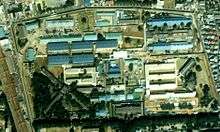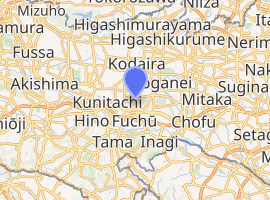Fuchū Prison
Fuchū Prison (府中刑務所, Fuchū keimusho) is a prison in Japan.[1] It is located in the city of the Fuchū, Tokyo to the west of the center of Tokyo Metropolis.[2] Before the end of World War II, Fuchū prison held Communist leaders, members of banned religious sects, and leaders of the Korean independence movement.[3]
 Aerial photograph of Fuchū Prison | |

| |
| Location | Fuchū, Tokyo, Japan |
|---|---|
| Coordinates | 35°41′3.6″N 139°28′26.3″E |
| Security class | Operational |
| Capacity | 2842 |
| Population | 2086 (as of December 2015) |
| Opened | 1935 |
| Managed by | Ministry of Justice (Japan) |
Fuchū Prison was opened in June 1935 after the need for a new and larger prison was determined by the Home Ministry in a review following the 1923 Great Kantō earthquake, during which Tokyo's main prison, Sugamo Prison was destroyed. During the pre-war period, the prison also housed many political prisoners as well as common criminals.
After the war, the prison was visited by Harold Isaac of Newsweek, French correspondent Robert Guillain, John K. Emmerson, E. Herbert Norman and[4][5] Domei reporter Tay Tateishi.[6]
The 1968 “300 million yen robbery” took place outside of the walls of the prison.
The prison facilities were renovated over a ten-year period from 1986 to 1995.
As of December 2015, Fuchū Prison was the largest prison in Japan, housing 2086 prisoners. The prison covers an area of 22.6 ha (56 acres), and is surrounded by a 1.8 km (1.1 mi) wall with a height of 5.5 m (18 ft), The cells are divided into four blocks (ordinary prisoners, foreign prisoners, mentally ill prisoners, and physically disabled or injured prisoners). Male foreign prisoners in Japan are generally housed at Fuchū Prison.[7] The prison also contains numerous workshops for vocational training. Foreigners are incarcerated for various crimes but all in single cells in two or three blocks.
Notable inmates
- Tokuda Kyuichi[8]
- Yoshio Shiga (Communist)[9]
- Kim Chon-hae[10]
- Richard Hinds, American murderer[11]
- Kenichi Shinoda - Japanese Yakuza.
- Yoshie Shiratori
References
- Institute of Pacific Relations. Hearings before the Subcommittee to Investigate the Administration of the Internal Security Act and Other Internal Security Laws of the Committee on the Judiciary, United States Senate Eighty_Second Congress First Session On The Institute Of Pacific Relations Part 3 September 14, 18, 19, 20, 25, 1951. Washington, U.S. Govt. Print. Off. 1951. pp. 747–753.
- Takemae, Eiji (2003). Allied Occupation of Japan. A&C Black.
- "Japanese Policy "Based Upon Righteousness"". The Guardian. 10 October 1945.
- Institute of Pacific Relations. Hearings before the Subcommittee to Investigate the Administration of the Internal Security Act and Other Internal Security Laws of the Committee on the Judiciary, United States Senate Eighty_Second Congress First Session On The Institute Of Pacific Relations Part 3 September 14, 18, 19, 20, 25, 1951. Washington, U.S. Govt. Print. Off. 1951. pp. 747–753.
- Takemae, Eiji (2003). Allied Occupation of Japan. A&C Black.
- "JAPAN TO URGE TRADE OF SILK FOR VITAL FOOD To Ask Permission for Barter System; Communists Would Get Rid of Mikadoism". The Montreal Gazette. Oct 4, 1945.
- "Arrest of a US Person". Tokyo, Japan – Embassy of the United States.
- Takemae, Eiji (2003). Allied Occupation of Japan. A&C Black.
- Takemae, Eiji (2003). Allied Occupation of Japan. A&C Black.
- Takemae, Eiji (2003). Allied Occupation of Japan. A&C Black.
- https://www.pressreader.com/ireland/wexford-people/20180123/282132111866022
Further reading
- Kyuichi Tokuda, Yoshio Shiga (1947). Eighteen Years in Prison. Jiji Press.
External links
- Fuchu Prison Exterior Shiga Yoshio previous release 球一 Tokuda 球一 addressed Tokuda (in Japanese). Wazee Digital Commerce. 10 October 1945.
- Fuchu Prison inmate Kyuichi Tokuda expresses joy at his release while former inmate Tosaji Obara, finance director of the Japan Holiness Church, says his religious beliefs were suppressed while he was incarcerated (in Japanese). NHK. 7 November 1945.
- "Japanese Diet Called Farce". The Tuscaloosa News. Oct 5, 1945.
- "Japs to Free 3000 Political Prisoners New Premier Set To Pick Cabinet". The Pittsburgh Press. Oct 7, 1945.
- "COMMUNISTS SAY BLOOD WILL FLOW IN JAPAN". The Evening Advocate. Oct 4, 1945.